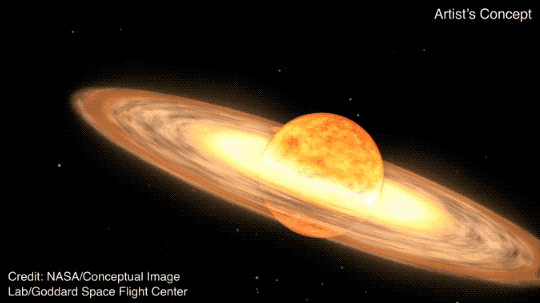Outer Space
A Rare Nova Explosion Will Soon Bring a 'New Star' to the Night Sky—How to Catch a Glimpse
In an event that occurs only once every 80 years, a distant remnant of a star will grow much brighter, briefly becoming visible to Earth
A Stellar Collision Birthed the 'Dragon's Egg' Nebula, a Puzzling Structure in the Milky Way
The colorful cloud of gas and dust has a violent origin—and this explains the unusual traits of two massive stars within it, astronomers say
Astronomers Discover a 'Sleeping Giant' Black Hole in Our Galaxy—the Second-Closest Known to Earth
Called Gaia BH3, the dormant black hole is 33 times more massive than the sun, making it the largest recorded stellar black hole in the Milky Way
The Seven Most Amazing Discoveries We’ve Made by Exploring Mercury
Only two robotic missions have made it to the Swift Planet, but they were crucial for upending many false assumptions of that sun-scorched world
Meteorites Are Becoming Harder to Find as They Sink Into Antarctica's Melting Ice
The disappearing space rocks are burying valuable clues into the history and composition of our solar system, according to a new study
How to Watch the Brilliant Lyrid Meteor Shower This Month
Fiery streaks will illuminate the night sky from April 15-29, with the spectacle's peak occurring from April 21-22
See NASA’s Initial Moon Buggy Concepts, Expected on the Moon by 2030
Three companies are competing to design NASA's lunar terrain vehicle (LTV) for the agency’s Artemis campaign
Watch the Total Solar Eclipse From Your Home With These Live Streams Online
Not in the path of totality? See the moon blot out the sun, revealing its magnificent corona, from your computer or phone
How Do Animals React to a Total Solar Eclipse? Scientists Document Strange and Surprising Behaviors
Nature enthusiasts work with researchers to figure out how creatures respond to the celestial phenomenon
NASA Will Create a New Time Zone for the Moon, Called Coordinated Lunar Time
With dozens of lunar missions on the horizon, a standard time-keeping system for the moon will assist with precise navigation, docking and landing
Falling Object That Crashed Into Florida Home May Be Debris From the International Space Station
Nobody was hurt by the mysterious, two-pound object, but experts speculate it may be a piece of batteries ejected from the station in 2021
Listen Live to the Total Solar Eclipse, Transformed Into a Real-Time Musical Composition
A composer based at San Francisco’s Exploratorium museum will use data coming from the eclipsed sun to create an out-of-this-world “sonification” on April 8
Astronomers Capture Dazzling New Image of the Black Hole at the Milky Way's Center
The first image of the black hole taken in polarized light, the new view shows the supermassive structure's magnetic fields and hints that it could be hiding an enormous jet
Why Scientists Are Calling for the Moon to Be Better Protected From Development
Only a few lunar sites are ideal for certain cutting-edge research—and they’re under threat from mining, satellites and bases, scientists argue
Titan's Massive Dunes May Be a Comet and Moon Graveyard From the Early Solar System
A new modeling study suggests the dark dunes on Saturn's largest moon are made of tiny particles created by crashing comets and moonlets billions of years ago
Five Fascinating Science Projects Using the Total Solar Eclipse to Illuminate New Discoveries
The NASA-supported experiments are mobilizing legions of researchers and volunteers to capture wide-ranging observations during totality, from amateur radio operations to elusive solar plumes to unusual animal behavior
Mars Has an Unexpected Influence on Earth's Oceans and Climate, Repeating Every 2.4 Million Years, Study Finds
The gravitational interactions between Mars and Earth as they orbit the sun may have periodically promoted a warmer climate and changes in ocean circulation on our home planet
You Can See a Rare, Bright Comet This Month. Will It Be Visible During the Solar Eclipse?
Comet 12P/Pons-Brooks is a frigid, volcanic ice ball that won’t pass near Earth again until 2095
See the Messages NASA Will Send to Space on Its Upcoming Mission to Europa
A metal plate affixed to the Europa Clipper is engraved with a poem, tributes to scientists and waveforms representing the word "water" in 103 languages, among other drawings
A History of Total Solar Eclipses Seen by Astronauts From Outer Space
Since the Gemini 12 mission in 1966, a handful of people have seen these stunning celestial events from orbit—or watched the moon’s shadow pass over Earth
Page 6 of 74

:focal(1094x1354:1095x1355)/https://tf-cmsv2-smithsonianmag-media.s3.amazonaws.com/filer_public/29/3e/293ecff1-66d0-4e59-b1af-4e2a5e17339b/dragon1.jpg)
:focal(580x331:581x332)/https://tf-cmsv2-smithsonianmag-media.s3.amazonaws.com/filer_public/19/32/19321ec4-4ae9-4749-ad51-7ec75adbf27a/gaia1.webp)
:focal(720x542:721x543)/https://tf-cmsv2-smithsonianmag-media.s3.amazonaws.com/filer_public/11/a8/11a8f779-8331-4682-8899-246f3c2815ba/main_esa_ssiow_iridescent_mercury_web.jpg)
:focal(930x700:931x701)/https://tf-cmsv2-smithsonianmag-media.s3.amazonaws.com/filer_public/2f/af/2faf224c-16ac-4efd-8bb9-e19576c87625/arctic2.jpg)
:focal(4330x2887:4331x2888)/https://tf-cmsv2-smithsonianmag-media.s3.amazonaws.com/filer_public/10/0e/100e6843-676a-4707-b81e-79588851dda4/gettyimages-1220506373.jpg)
:focal(512x290:513x291)/https://tf-cmsv2-smithsonianmag-media.s3.amazonaws.com/filer_public/b9/29/b92903be-3fe2-459e-8dba-82551f19b9ab/lunar_buggy_2.webp)
:focal(3072x2048:3073x2049)/https://tf-cmsv2-smithsonianmag-media.s3.amazonaws.com/filer_public/f2/d0/f2d06687-f8a6-4950-b6c5-8fd5f42e036e/36336061393_f5361c15f0_6k.jpg)
:focal(800x602:801x603)/https://tf-cmsv2-smithsonianmag-media.s3.amazonaws.com/filer_public/87/d6/87d61ed0-16df-452f-9d5e-7710a4dcd105/eclipseanimals-v2.jpg)
:focal(2075x2075:2076x2076)/https://tf-cmsv2-smithsonianmag-media.s3.amazonaws.com/filer_public/10/82/108246d6-4b9b-44cc-8d85-e6478b5704fd/moom.jpg)
:focal(1511x1007:1512x1008)/https://tf-cmsv2-smithsonianmag-media.s3.amazonaws.com/filer_public/79/52/7952dc07-6f20-4ef4-81df-1a6d52ad2928/0701891orig.jpg)
:focal(360x207:361x208)/https://tf-cmsv2-smithsonianmag-media.s3.amazonaws.com/filer_public/7a/f9/7af9a4bb-32a7-463e-a681-f86cddcdc135/eclipse_1-1280-1.webp)
:focal(1000x1000:1001x1001)/https://tf-cmsv2-smithsonianmag-media.s3.amazonaws.com/filer_public/05/fd/05fd3550-7ef1-46e3-9229-188eb270a02b/sgra_polarimetric_press_image-032724-lores.jpg)
:focal(1527x1534:1528x1535)/https://tf-cmsv2-smithsonianmag-media.s3.amazonaws.com/filer_public/c5/70/c5705fb3-b875-4cf5-b01a-e463795178f9/moona2.jpg)
:focal(762x434:763x435)/https://tf-cmsv2-smithsonianmag-media.s3.amazonaws.com/filer_public/77/28/772863a6-f8bc-4b47-ac3e-4ca78a6d115a/titan2.webp)
:focal(450x339:451x340)/https://tf-cmsv2-smithsonianmag-media.s3.amazonaws.com/filer_public/b4/37/b4370cf8-9d77-4795-a3fa-63c5549e5c5b/ezgif-7-192a70d806_cropped.jpg)
:focal(681x512:682x513)/https://tf-cmsv2-smithsonianmag-media.s3.amazonaws.com/filer_public/0a/d7/0ad73452-f6d2-47e4-ad5b-d4bc1abae738/ezgif-3-0b922f8a81_cropped.jpg)
:focal(2190x1439:2191x1440)/https://tf-cmsv2-smithsonianmag-media.s3.amazonaws.com/filer_public/ec/e0/ece0719b-6ecc-417d-a3e3-7b1dfea815e1/pons_brooks.jpg)
:focal(1150x854:1151x855)/https://tf-cmsv2-smithsonianmag-media.s3.amazonaws.com/filer_public/d0/5d/d05d89db-9935-4c3d-b957-1eaa6e91c8d5/pia19048.jpg)
:focal(2784x1856:2785x1857)/https://tf-cmsv2-smithsonianmag-media.s3.amazonaws.com/filer_public/00/ab/00ab5453-811b-405b-9a04-08564356478b/iss063-e-31763.jpeg)